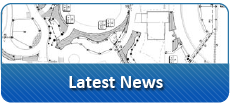With water prices going up along with our awareness of water scarcity, we are often asked how to decrease water used for irrigation. Here are a few of our tactics for reducing the overall water used by an irrigation system:
Reduce Site Water Requirements
One of the simplest ways to decrease water used for irrigation is to limit the turf areas that require a high amount of water, along with plants that have moderate to high water needs. Replace plants and turf areas with hearty/native plants that can survive with less water.
Improve Distribution Uniformity (DU)
Oftentimes, facility managers will run the sprinklers longer if they see that there are dry/brown spots. Not only does this decrease water efficiency, it is ineffective. Dry spots are a result of poor sprinkler head spacing and placement. Distribution uniformity means placing the sprinkler heads properly so that water will be distributed evenly across the entire lawn, or planted area. Using equipment that has a more consistent application rate in turf areas to eliminate dry areas will also work to achieve even distribution of water.
Use Pressure Regulation
Pressure regulation helps ensure that sprinklers are operating at the optimal level. When pressure is too high, water droplets atomize, which results in significant amounts of water being carried off-site by wind drift. By reducing the operating pressure, the water drops are larger and heavier, and are more likely to land where intended.
Convert to Drip Irrigation
Convert sprinklers (within plant beds) over to drip irrigation so water has less of a chance to evaporate and/or runoff. Drip irrigation is about 90-95% efficient, while spray heads and rotors are about 60-65% efficient.
Improve Management Practices
Make sure property managers remember to check the sprinklers once a week. Since the sprinklers usually operate after work hours, property managers may not know when a sprinkler head isn’t operating properly. A good practice is running the zones once a week to check that the whole system is in working order.
Use Smart Controllers
Smart controllers determine the watering durations and frequencies on a daily basis based on the real-time weather conditions. They adjust run times based on the needs of all the various plant types; some days, certain zones may not need to run at all. The controller relies on you to input the correct soil and plant type. It is important to remember that these controllers are only as good as the information you input. If you are considering using a smart controller, you must be able to assess and document the various site features present within each zone (plants, soils, exposure, shade, slope, root depth).



